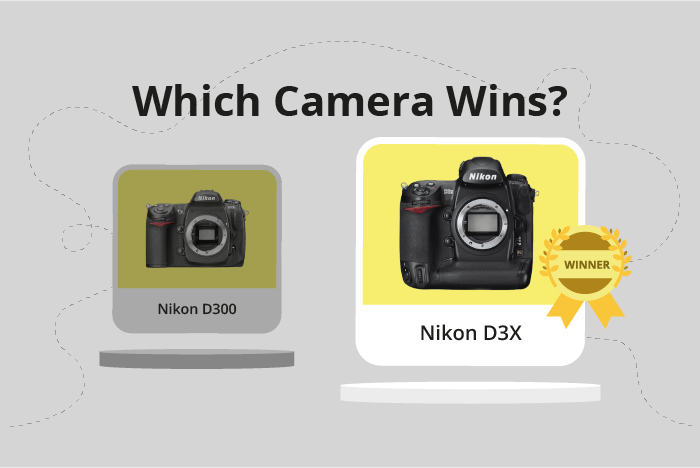Nikon D300 vs D3X Comparison
Nikon D300

Nikon D3X

The Nikon D3X takes the lead with a score of 64/100, while the Nikon D300 trails behind at 49/100. Both cameras are DSLR models, announced in 2007 and 2008 respectively. They share similarities in their camera type and design.
The D3X stands out with its higher score, reflecting its superior performance. However, the D300 has an advantage in terms of price, with a launch price of $1540 compared to the D3X’s hefty $9172. Additionally, the D300 is lighter and more compact, measuring 147 x 114 x 74mm and weighing 925g, while the D3X measures 160 x 157 x 88mm and weighs 1260g.
Taking these factors into account, the Nikon D3X offers better performance, but the D300 provides a more budget-friendly and portable option.
Nikon D300 vs D3X Overview and Optics
The Nikon D3X emerges as the winner in the optics comparison, scoring 65/100, while the Nikon D300 lags behind with a score of 47/100. Both cameras share some common specifications, such as a CMOS sensor, Expeed processor, Nikon F lens mount, and the lack of image stabilization. However, there are significant differences between the two cameras that contribute to the D3X’s higher score.
The Nikon D3X boasts a higher megapixel count of 24.5, compared to the D300’s 12.3 megapixels. This means the D3X is capable of capturing more detail and producing higher resolution images, which is an important factor for professional photographers. Furthermore, the D3X has a full-frame sensor, whereas the D300 uses an APS-C sensor. Full-frame sensors generally provide better image quality, especially in low light conditions, and offer a shallower depth of field for more pleasing bokeh. The D3X also has a higher DXOMARK score for its sensor, at 88, compared to the D300’s score of 67, reflecting the overall better performance of the sensor.
On the other hand, the Nikon D300 has a faster shooting speed of 6 frames per second, compared to the D3X’s 5 frames per second. This could be advantageous for photographers who need to capture fast-moving subjects, such as sports or wildlife. However, this advantage does not outweigh the superior image quality and resolution offered by the D3X.
Taking these factors into account, the Nikon D3X stands out as the better camera in terms of optics, offering higher resolution, better image quality, and a superior sensor. The Nikon D300’s faster shooting speed may be advantageous in certain situations, but it is not enough to surpass the overall performance of the D3X.
Nikon D300 vs D3X Video Performance
When examining the video capabilities of the Nikon D300 and Nikon D3X, it is important to note that neither camera has video functionality. This means that both cameras are unable to record video footage. The absence of video features does not determine which camera is better, but simply highlights a missing feature in both models.
Nikon D300 vs D3X Features and Benefits
The Nikon D300 and Nikon D3X both have a feature score of 54 out of 100, indicating that these cameras share many similarities in their features. Both cameras have a 3-inch screen, with the D300 having a slightly higher screen resolution of 922,000 dots compared to the D3X’s 920,000 dots. Neither camera has a touchscreen, flip screen, GPS, WiFi, or Bluetooth.
The winning camera in terms of features is not clear-cut, as both cameras share the same score. However, there are some minor differences that can set them apart. The Nikon D300 has a marginally higher screen resolution, which may provide a slightly clearer image preview and menu navigation experience. This difference, though small, may be a deciding factor for some users who prioritize image clarity on their camera’s screen.
On the other hand, the Nikon D3X does not have any specific advantages over the D300 in terms of features. Both cameras lack modern connectivity options such as WiFi and Bluetooth, which may be a drawback for users who require quick and easy photo sharing or remote control capabilities.
Considering the shared features and minor differences between the Nikon D300 and Nikon D3X, it is difficult to determine a clear winner. The D300 has a slightly higher screen resolution, but this advantage is minimal and may not significantly impact the user experience. Both cameras lack several modern features, which may be a deal-breaker for some potential buyers. Ultimately, the decision between these two cameras will likely come down to personal preference and other factors such as price, performance, and overall design.
Nikon D300 vs D3X Storage and Battery
The Nikon D3X triumphs over the Nikon D300 in storage and battery with a score of 87/100, compared to the D300’s 43/100. Both cameras utilize Compact Flash (Type I or II) memory cards, and neither offers USB charging. However, the D3X excels in two key aspects.
Firstly, the D3X provides two memory card slots, granting more storage capacity and flexibility. It also accepts UDMA cards, allowing for faster data transfer. Secondly, the D3X boasts a remarkable battery life of 4400 shots, powered by the EN-EL4a battery. This significantly surpasses the D300, which offers 1000 shots using the EN-EL3e battery.
The D300 has no clear advantages in storage and battery. Consequently, the D3X proves to be the superior choice regarding storage capacity, memory card compatibility, and battery life, making it a more reliable option for extended shooting sessions.
Nikon D300 vs D3X – Our Verdict
Are you still undecided about which camera is right for you? Have a look at these popular comparisons that feature the Nikon D300 or the Nikon D3X:

